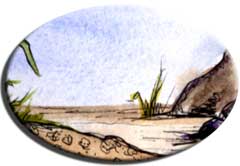Why is sediment quality important?
 Sediment in streams can be
contaminated with a variety of pollutants from sources including industrial and agricultural runoff, wastewater treatment plants, and storm water. Exposure
to contaminated sediment can have a significant effect on the health, diversity, and abundance of all life in streams. Contaminants in sediment can also
be released back into the stream, affecting water quality long after the original source of pollution has been removed. Monitoring sediment quality can
help managers assess stream health and focus on places where cleanup efforts are needed.
Sediment in streams can be
contaminated with a variety of pollutants from sources including industrial and agricultural runoff, wastewater treatment plants, and storm water. Exposure
to contaminated sediment can have a significant effect on the health, diversity, and abundance of all life in streams. Contaminants in sediment can also
be released back into the stream, affecting water quality long after the original source of pollution has been removed. Monitoring sediment quality can
help managers assess stream health and focus on places where cleanup efforts are needed.
Sediment eroded from nearby roads and construction areas can also act as a pollutant. Entering a steam, eroded sediment can fill the spaces in gravel beds making them less useable for salmon to spawn or filling pools making them more shallow and prone to increased temperatures.
How do we measure sediment quality?
To measure sediment quality, managers can measure pollutant concentrations in sediment and perform tests to determine if the sediment is toxic to organisms that may live there.
- Sediment Toxicity data
- Sediment Pollution - future pages will contain data from chemical analysis of pollutants in sediments

